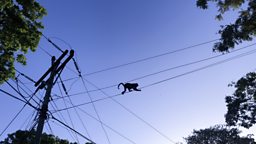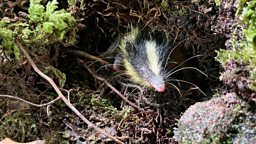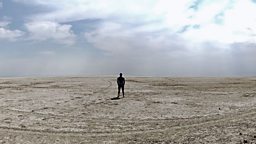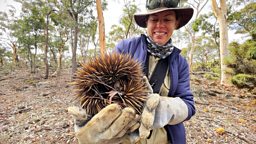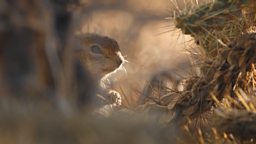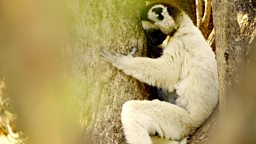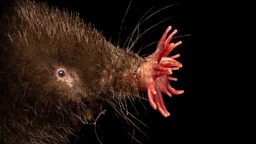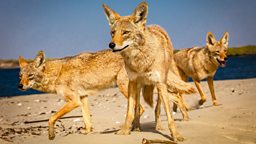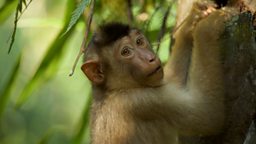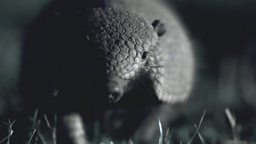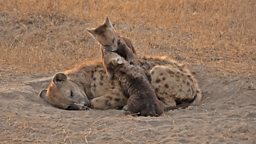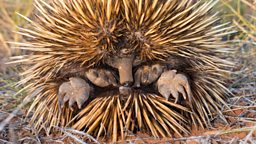Mole-rats: A life in permanent darkness
By Mammals Researcher, Amy Downes
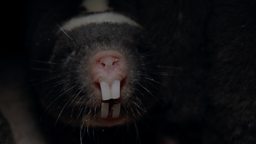
From the beginning of our research phase for the ‘Dark’ episode of Mammals, we knew that we would have some very challenging filming conditions given that most cameras can only record when there is loads and loads of light, and we were trying to film the very opposite. We also knew that we really wanted to film an animal that lived in perpetual darkness, to illuminate (pardon the pun) the very extremes of this episode’s environment.
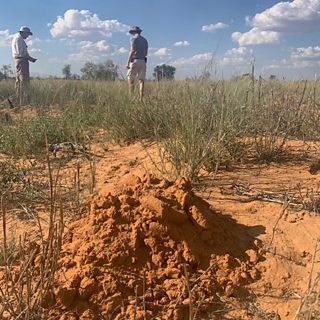
The African mole-rats are an intriguing group of Mammals, and we started talking to research groups and scientists that were studying their behaviour. It’s thought that Damaraland mole-rats live permanently underground to avoid the heat of the day and predators, only rarely venturing to the surface in search of mating opportunities and when their tunnels get flooded, and as such they have become subterranean specialists. They are a social species of mole-rat – similar to naked mole-rats – but fascinatingly this sociality has evolved independently in the two species. Naked mole-rats evolved in eastern Africa, and Damarland mole-rats further south – almost on opposite sides of the continent. They live in social groups with one breeding female, the queen, who is at the top of the hierarchy, and therefore the boss!
The scientists (at the University of Pretoria and Kalahari Meerkat Project) really helped us to work out the best way we could film the mole-rats whilst not interrupting their natural behaviour. When studying them in the wild, researchers painstakingly locate mole-rat colonies by doing vast transects of the landscape to spot the red-sand mounds that the mole-rats dig up when creating their underground labyrinth. So, we knew that with help we could find these locations and film their mole hills above ground, but after talking through strategies to access the tunnel systems, we realised it would be impossible to film underground without causing major disturbance to the animals and their homes.
Luckily for us there were several colonies at the University of Pretoria. These families, each with up to 30 Damaraland mole-rats, are regularly used by researchers to unravel their complex suite of social behaviours; thus we could also get close enough to film them. We also relied on the experts to inform us exactly what these underground tunnel systems looked and felt like – the tunnels themselves are at specific depths depending on their use, and there are chambers of different sizes for nesting, caching food and going to the toilet! Each section also had to be at an exact temperature (between 18°C and 28°C for the mole-rats to be comfortable and behave as normal.
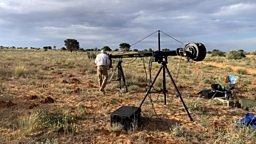
When we arrived in South Africa, Camera Operator John Brown and I couldn’t wait to get started building these realistic homes for the mole-rats to inhabit for the duration of our filming. Initially we spent 3 days constructing and perfecting the enclosed tunnels in exactly the correct proportions, and with sections, the mole-rats could dig through to find their food: plant tubers.
Iβd filmed Damaraland mole-rats 20 years previously but for this sequence we were much more ambitiousMammals Camera Operator, John Brown
John is a real expert at building work like this and had also specially built a rig for our camera that would enable us to get really interesting perspectives down the tunnels. This, coupled with the scientists being on-hand to check the dimensions, sand density, and authenticity of our build, and welfare of the mole-rats, meant that I thought we were on to a winner of a sequence. Little did we know the mole-rats were going to be so much more challenging than we bargained for – they were whirlwinds of energy, with gnashing front incisors that seemed able to cut through anything with rapid and erratic movements meaning they were extremely difficult to film. As much as we were in awe watching them, and how characterful they were, we realised we were in for a tricky month’s shoot. Here is John’s account:
“To film the mole-rats I used a specialised computer-controlled camera rig that I’d built during the lockdown of 2020. This allowed me to programme complex flowing moves to ‘fly’ the camera within the tunnels we’d built, [sort of like a miniature drone]. I’d previously used this rig everywhere from the Amazonian rainforest to the streets of Manhattan, but nothing was more challenging than filming the mole-rats.
I’d filmed Damaraland mole-rats 20 years previously but for this sequence we were much more ambitious and wanted the camera to feel as if it was inside the tunnels that make up the mole-rat’s world. In many ways we were victims of our own ambition - the tunnels and chambers we painstakingly built to replicate the mole-rat’s environment proved so exciting for them that within minutes they would revert to type; charging around the tunnels like kids in an adventure playground and, most challengingly for us, deploying their formidable burrowing skills.
A network of tunnels that might take us a day to build could be destroyed in minutes - the mole-rats had an uncanny ability to find and exploit any weakness, chewing through our thick, cement-hard, tunnel lining like it was warm butter. As exasperating as this was, we’d get to work repairing the damage in the knowledge we’d provided these fantastic creatures with a life enriching experience!”
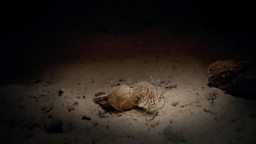
Having the mole-rats literally destroy everything we had created, whilst infuriating, did make us realise what incredible and voracious diggers they were.
We were really pleased that for the βDarkβ episode of Mammals, we could reveal these amazing creatures
After a big rainstorm in the Kalahari (which softens up the earth), a colony of mole-rats can dig nearly a kilometre of new tunnels and shift nearly three tonnes of soil onto the surface above. They must do a lot of their food-sourcing and tunnel expansion in this timeframe because otherwise, the earth can be too hard and difficult to dig through without a lot of effort. They cache the abundance of food in their larder chamber, and it keeps the whole colony alive through the dry season. So, this frenzied digging period became the focus of our sequence.
It’s not exactly known how mole-rats navigate underground and manage to dig towards food, but what was clear from observing them, is that they can explore in complete darkness with ease, using their whiskers to feel their way, and slightly longer hairs on their bodies to sense direction and space, yet the mechanism that allows them to master the underground is still not fully understood.
Damaraland mole-rats are a species of mammal that a very limited number of people have been lucky enough to see behave naturally in their underground world. We were really pleased that for the ‘Dark’ episode of Mammals, we could reveal these amazing creatures, their characters, and how they live their lives.


